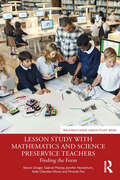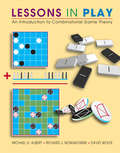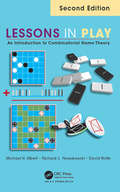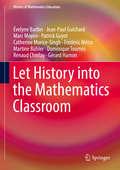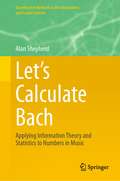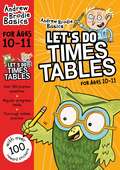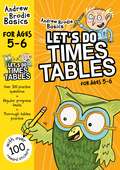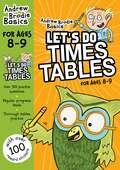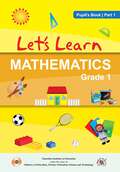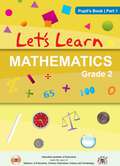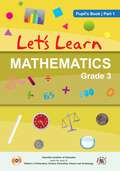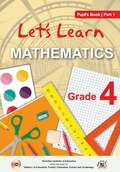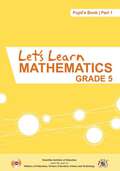- Table View
- List View
Lesson Study: A Japanese Approach To Improving Mathematics Teaching and Learning (Studies in Mathematical Thinking and Learning Series)
by Clea Fernandez Makoto YoshidaLesson study is a popular professional development approach in Japan whereby teachers collaborate to study content, instruction, and how students solve problems and reach for understanding in order to improve elementary mathematics instruction and learning in the classroom. This book is the first comprehensive look at the system and process of lesson study in Japan. It describes in detail the process of how teachers conducted lesson study--how they collaborated in order to develop a lesson, what they talked about during the process, and what they looked at in order to understand deeply how students were learning. Readers see the planning of a mathematics lesson, as well as how much content knowledge the teachers have. They observe students' problem solving strategies and learn how Japanese teachers prepare themselves to identify those strategies and facilitate the students' discussion. Written for mathematics teachers, educational researchers, school administrators interested in teachers' professional development, and professional developers, this landmark volume provides an in-depth understanding of lesson study that can lead to positive changes in teachers' professional development and in teaching and learning in the United States.
Lesson Study: A Japanese Approach To Improving Mathematics Teaching and Learning (Studies in Mathematical Thinking and Learning Series)
by Clea Fernandez Makoto YoshidaLesson study is a popular professional development approach in Japan whereby teachers collaborate to study content, instruction, and how students solve problems and reach for understanding in order to improve elementary mathematics instruction and learning in the classroom. This book is the first comprehensive look at the system and process of lesson study in Japan. It describes in detail the process of how teachers conducted lesson study--how they collaborated in order to develop a lesson, what they talked about during the process, and what they looked at in order to understand deeply how students were learning. Readers see the planning of a mathematics lesson, as well as how much content knowledge the teachers have. They observe students' problem solving strategies and learn how Japanese teachers prepare themselves to identify those strategies and facilitate the students' discussion. Written for mathematics teachers, educational researchers, school administrators interested in teachers' professional development, and professional developers, this landmark volume provides an in-depth understanding of lesson study that can lead to positive changes in teachers' professional development and in teaching and learning in the United States.
Lesson Study Research and Practice in Mathematics Education: Learning Together
by Lynn C. Hart, Alice S. Alston and Aki MurataLesson study is a professional development process that teachers engage in to systematically examine their practice, with the goal of becoming more effective. Originating in Japan, lesson study has gained significant momentum in the mathematics education community in recent years. As a process for professional development, lesson study became highly visible when it was proposed as a means of supporting the common practice of promoting better teaching by disseminating documents like standards, benchmarks and nationally validated curricula. While the body of knowledge about lesson study is growing, it remains somewhat elusive and composed of discrete research endeavors. As a new research area there is no coherent knowledge base yet. This book will contribute to the field bringing the work of researchers and practitioners together to create a resource for extant work. This book describes several aspects of Lesson Study, amongst others: it gives an historical overview of the concept, it addresses issues related to learning and teaching mathematics, it looks at the role of the teacher in the process. The last two sections of the book look at how lesson Study can be used with preservice mathematics teachers and at university mathematics methods teaching.
Lesson Study with Mathematics and Science Preservice Teachers: Finding the Form (WALS-Routledge Lesson Study Series)
by Sharon Dotger Gabriel Matney Jennifer Heckathorn Kelly Chandler-Olcott Miranda FoxThis insightful volume offers an overview of the fundamentals of lesson student practice in US teacher education as well as examples from math and science teacher educators using lesson study in their local contexts. The number of teacher educators using lesson study with preservice teachers is small but growing. This book is aimed at teacher educators who may want to try lesson study in university contexts without the challenge of translating the practice from the K-12 context on their own. In this volume, lesson study is broadly overviewed, attention is given to its constituent steps, and examples of lesson study in preservice contexts are shared. Given the broad array of teacher education program designs, numerous contingencies guide teacher educators in their implementation of lesson study, given their contextual affordances and limitations. The lesson study descriptions and cases in this book will support teacher educators and scholars across subject specialities and geographic lines, as they seek instructional frameworks to advance their pedagogical goals.
Lesson Study with Mathematics and Science Preservice Teachers: Finding the Form (WALS-Routledge Lesson Study Series)
This insightful volume offers an overview of the fundamentals of lesson student practice in US teacher education as well as examples from math and science teacher educators using lesson study in their local contexts. The number of teacher educators using lesson study with preservice teachers is small but growing. This book is aimed at teacher educators who may want to try lesson study in university contexts without the challenge of translating the practice from the K-12 context on their own. In this volume, lesson study is broadly overviewed, attention is given to its constituent steps, and examples of lesson study in preservice contexts are shared. Given the broad array of teacher education program designs, numerous contingencies guide teacher educators in their implementation of lesson study, given their contextual affordances and limitations. The lesson study descriptions and cases in this book will support teacher educators and scholars across subject specialities and geographic lines, as they seek instructional frameworks to advance their pedagogical goals.
Lessons in Enumerative Combinatorics (Graduate Texts in Mathematics #290)
by Adriano M. Garsia Ömer EğecioğluThis textbook introduces enumerative combinatorics through the framework of formal languages and bijections. By starting with elementary operations on words and languages, the authors paint an insightful, unified picture for readers entering the field. Numerous concrete examples and illustrative metaphors motivate the theory throughout, while the overall approach illuminates the important connections between discrete mathematics and theoretical computer science. Beginning with the basics of formal languages, the first chapter quickly establishes a common setting for modeling and counting classical combinatorial objects and constructing bijective proofs. From here, topics are modular and offer substantial flexibility when designing a course. Chapters on generating functions and partitions build further fundamental tools for enumeration and include applications such as a combinatorial proof of the Lagrange inversion formula. Connections to linear algebra emerge in chapters studying Cayley trees, determinantal formulas, and the combinatorics that lie behind the classical Cayley–Hamilton theorem. The remaining chapters range across the Inclusion-Exclusion Principle, graph theory and coloring, exponential structures, matching and distinct representatives, with each topic opening many doors to further study. Generous exercise sets complement all chapters, and miscellaneous sections explore additional applications. Lessons in Enumerative Combinatorics captures the authors' distinctive style and flair for introducing newcomers to combinatorics. The conversational yet rigorous presentation suits students in mathematics and computer science at the graduate, or advanced undergraduate level. Knowledge of single-variable calculus and the basics of discrete mathematics is assumed; familiarity with linear algebra will enhance the study of certain chapters.
Lessons in Play: An Introduction to Combinatorial Game Theory
by Michael AlbertCombinatorial games are games of pure strategy involving two players, with perfect information and no element of chance. Starting from the very basics of gameplay and strategy, the authors cover a wide range of topics, from game algebra to special classes of games. Classic techniques are introduced and applied in novel ways to analyze both old and
Lessons in Play: An Introduction to Combinatorial Game Theory, Second Edition
by Michael H. Albert Richard J. Nowakowski David WolfeThis second edition of Lessons in Play reorganizes the presentation of the popular original text in combinatorial game theory to make it even more widely accessible. Starting with a focus on the essential concepts and applications, it then moves on to more technical material. Still written in a textbook style with supporting evidence and proofs, the authors add many more exercises and examples and implement a two-step approach for some aspects of the material involving an initial introduction, examples, and basic results to be followed later by more detail and abstract results. Features Employs a widely accessible style to the explanation of combinatorial game theory Contains multiple case studies Expands further directions and applications of the field Includes a complete rewrite of CGSuite material
Lessons in Scientific Computing: Numerical Mathematics, Computer Technology, and Scientific Discovery
by Norbert SchorghoferTaking an interdisciplinary approach, this new book provides a modern introduction to scientific computing, exploring numerical methods, computer technology, and their interconnections, which are treated with the goal of facilitating scientific research across all disciplines. Each chapter provides an insightful lesson and viewpoints from several subject areas are often compounded within a single chapter. Written with an eye on usefulness, longevity, and breadth, Lessons in Scientific Computing will serve as a "one stop shop" for students taking a unified course in scientific computing, or seeking a single cohesive text spanning multiple courses. Features: Provides a unique combination of numerical analysis, computer programming, and computer hardware in a single text Includes essential topics such as numerical methods, approximation theory, parallel computing, algorithms, and examples of computational discoveries in science Written in a clear and engaging style Not wedded to a specific programming language
Lessons in Scientific Computing: Numerical Mathematics, Computer Technology, and Scientific Discovery
by Norbert SchorghoferTaking an interdisciplinary approach, this new book provides a modern introduction to scientific computing, exploring numerical methods, computer technology, and their interconnections, which are treated with the goal of facilitating scientific research across all disciplines. Each chapter provides an insightful lesson and viewpoints from several subject areas are often compounded within a single chapter. Written with an eye on usefulness, longevity, and breadth, Lessons in Scientific Computing will serve as a "one stop shop" for students taking a unified course in scientific computing, or seeking a single cohesive text spanning multiple courses. Features: Provides a unique combination of numerical analysis, computer programming, and computer hardware in a single text Includes essential topics such as numerical methods, approximation theory, parallel computing, algorithms, and examples of computational discoveries in science Not wedded to a specific programming language
Lessons Learned from the Great East Japan Earthquake: Birth Outcomes in a Catastrophe in a Highly Aged Society (SpringerBriefs in Population Studies)
by Honami YoshidaThis book provides insights into the enormous impact of fetal and newborn loss in the aftermath of the natural disasters that Japanese society constantly has to face. It first reveals effect of the Great East Japan Earthquake in 2011 on the next generation and reproductive attitudes and shows that prenatal care strategies for emergencies had not been established by any local government in Japan. With continuing research on birth outcomes in the area surrounding the catastrophe, the authors emphasize the importance of the pre-hospital obstetric care team in disaster response and highlight the inequality in health care in a highly aging society like Japan, where perinatal health care is given lower priority than elderly care.Following the creation of a specialized project for pre and postnatal care the authors conducted surveys on how community preparedness in maternal and child health for post-disaster areas impacted population changes.This book is a valuable resource for researchers who are interested in the association between rapid population decline and the disaster management system for maternal and child health, as well as the effect of culture, gender bias, and family traditions.
Let History into the Mathematics Classroom (History of Mathematics Education)
by Évelyne Barbin Jean-Paul Guichard Marc Moyon Patrick Guyot Catherine Morice-Singh Frédéric Métin Martine Bühler Dominique Tournès Renaud Chorlay Gérard HamonThis book brings together 10 experiments which introduce historical perspectives into mathematics classrooms for 11 to 18-year-olds. The authors suggest that students should not only read ancient texts, but also should construct, draw and manipulate. The different chapters refer to ancient Greek, Indian, Chinese and Arabic mathematics as well as to contemporary mathematics. Students are introduced to well-known mathematicians—such as Gottfried Leibniz and Leonard Euler—as well as to less famous practitioners and engineers. Always, there is the attempt to associate the experiments with their scientific and cultural contexts. One of the main values of history is to show that the notions and concepts we teach were invented to solve problems. The different chapters of this collection all have, as their starting points, historic problems—mathematical or not. These are problems of exchanging and sharing, of dividing figures and volumes as well as engineers’ problems, calculations, equations and congruence. The mathematical reasoning which accompanies these actions is illustrated by the use of drawings, folding, graphical constructions and the production of machines.
Let the Evidence Speak: Using Bayesian Thinking in Law, Medicine, Ecology and Other Areas
by Alan JessopThis book presents the most important ideas behind Bayes’ Rule in a form suitable for the general reader. It is written without formulae because they are not necessary; the ability to add and multiply is all that is needed. As well as showing in full the application of Bayes’ Rule to some quantitatively simple, though not trivial, examples, the book also convincingly demonstrates that some familiarity with Bayes’ Rule is helpful in thinking about how best to structure one’s thinking.
Let’s Calculate Bach: Applying Information Theory and Statistics to Numbers in Music (Quantitative Methods in the Humanities and Social Sciences)
by Alan ShepherdThis book shows how information theory, probability, statistics, mathematics and personal computers can be applied to the exploration of numbers and proportions in music. It brings the methods of scientific and quantitative thinking to questions like: What are the ways of encoding a message in music and how can we be sure of the correct decoding? How do claims of names hidden in the notes of a score stand up to scientific analysis? How many ways are there of obtaining proportions and are they due to chance?After thoroughly exploring the ways of encoding information in music, the ambiguities of numerical alphabets and the words to be found “hidden” in a score, the book presents a novel way of exploring the proportions in a composition with a purpose-built computer program and gives example results from the application of the techniques. These include information theory, combinatorics, probability, hypothesis testing, Monte Carlo simulation and Bayesian networks, presented in an easily understandable form including their development from ancient history through the life and times of J. S. Bach, making connections between science, philosophy, art, architecture, particle physics, calculating machines and artificial intelligence. For the practitioner the book points out the pitfalls of various psychological fallacies and biases and includes succinct points of guidance for anyone involved in this type of research.This book will be useful to anyone who intends to use a scientific approach to the humanities, particularly music, and will appeal to anyone who is interested in the intersection between the arts and science.With a foreword by Ruth Tatlow (Uppsala University), award winning author of Bach’s Numbers: Compositional Proportion and Significance and Bach and the Riddle of the Number Alphabet.“With this study Alan Shepherd opens a much-needed examination of the wide range of mathematical claims that have been made about J. S. Bach's music, offering both tools and methodological cautions with the potential to help clarify old problems.” Daniel R. Melamed, Professor of Music in Musicology, Indiana University
Let's do Addition and Subtraction 7-8
by Andrew BrodieLet's Do Addition and Subtraction is a brand new series of six titles in the popular 'Let's Do' range. Each book addresses the new National Curriculum maths specifications and contains a rich variety of activity pages and progress tests, with over 400 questions in total. Topics include column addition and subtraction by decomposition and practice of basic number bonds.Designed to be used at home with parental support, each book includes fun tips and clues, as well as extra challenges in Brodie's Brain Boosters. Building up speed and confidence is key, and so these books feature progressively more difficult activities with a progress test at the end of each section. There is a clear answer section for reference by parents and children, together with over 100 bright, colourful reward stickers.
Let's do Arithmetic 7-8 (Mental Maths Tests)
by Andrew BrodieMatched to the demands of the National Curriculum and the new arithmetic tests at Key Stages 1 and 2, the Let's Do Arithmetic workbooks have been carefully devised to match the appropriate age and stage of your child. Each book contains 40 tests, which become progressively more challenging throughout to ensure progress can be made.With a recording chart for checking progress and full answers to aid your assessment, this book is the perfect way to test understanding of basic arithmetic concepts and prepare for the timed National Tests that your child will be encountering in school.
Let's do Times Tables 10-11
by Andrew BrodieFrom one of the most trusted education authors, and matched to the National Curriculum, this book offers all the practice and tips your child needs to boost their times tables!With 35 practice pages and 7 progress tests, each book includes over 300 questions accompanied by useful tips and extra advice from Olly the wise old owl. Further challenges, requiring children to apply problem-solving skills, are featured in Brodie's Brain Boosters.And because motivation and encouragement are key to a child's success, each book includes over 100 full colour reward stickers!
Let's do Times Tables 5-6
by Andrew BrodieFrom one of the most trusted education authors, and matched to the National Curriculum, this book offers all the practice and tips your child needs to boost their times tables!With 35 practice pages and 7 progress tests, each book includes over 300 questions accompanied by useful tips and extra advice from Olly the wise old owl. Further challenges, requiring children to apply problem-solving skills, are featured in Brodie's Brain Boosters.And because motivation and encouragement are key to a child's success, each book includes over 100 full colour reward stickers!
Let's do Times Tables 7-8
by Andrew BrodieFrom one of the most trusted education authors, and matched to the National Curriculum, this book offers all the practice and tips your child needs to boost their times tables!With 35 practice pages and 7 progress tests, each book includes over 300 questions accompanied by useful tips and extra advice from Olly the wise old owl. Further challenges, requiring children to apply problem-solving skills, are featured in Brodie's Brain Boosters.And because motivation and encouragement are key to a child's success, each book includes over 100 full colour reward stickers!
Let's do Times Tables 8-9
by Andrew BrodieFrom one of the most trusted education authors, and matched to the National Curriculum, this book offers all the practice and tips your child needs to boost their times tables!With 35 practice pages and 7 progress tests, each book includes over 300 questions accompanied by useful tips and extra advice from Olly the wise old owl. Further challenges, requiring children to apply problem-solving skills, are featured in Brodie's Brain Boosters.And because motivation and encouragement are key to a child's success, each book includes over 100 full colour reward stickers!
Let’s Learn Mathematics Part-1 - Pupil’s Book class 1 - MIE
by Mauritius Institute of EducationThe Mathematics Pupil’s Book Part 1 for Grade 1 offers a comprehensive foundation for young learners in fundamental mathematical concepts aligned with the National Curriculum Framework. Structured around three engaging themes - Home, School, and Games - the textbook incorporates a variety of activities, such as drawing, tracing, writing, coloring, matching, sorting, and comparing objects and numbers. These activities are designed to be interactive and enjoyable, fostering a child-friendly learning environment. Clear learning objectives and outcomes are outlined for each theme and unit, accompanied by continuous assessment and profiling exercises to gauge student progress. The textbook also features an annex with a memory game to reinforce recognition of shapes, colors, and numbers. Overall, it provides a well-rounded and interactive approach to cultivating essential mathematical skills in Grade 1 students.
Let’s Learn Mathematics Part-1 - Pupil's Book class 2 - MIE
by Mauritius Institute of EducationThe Grade 2 Mathematics Workbook and Teacher’s Book align with the philosophical principles of the New Curriculum Framework (Primary) and extend the pedagogical approaches from Grade 1. Designed to facilitate a smooth transition, the materials aim to enhance pupils' understanding and enjoyment of key mathematical concepts. Concepts are introduced sequentially through engaging stories, connecting them to real-life contexts, with an emphasis on interdisciplinary links, life skills, and ICT integration. Child-friendly presentation and progressive activities aid comprehension, while continuous assessment and profiling support educators in monitoring pupil progress. The role of educators as facilitators is underscored, encouraging them to leverage the 'Note to Teacher' for effective conceptual understanding. The Mathematics Panel anticipates that these curriculum materials will instill enjoyment and foster a deeper interest in the study of Mathematics among pupils.
Let’s Learn Mathematics Part-1 - Pupil’s Book class 3 - MIE
by Mauritius Institute of EducationThe Grade 3 Mathematics Pupil’s Book Part 1 offers a comprehensive exploration of key mathematical concepts essential for third-grade students. It covers Geometry, introducing shapes, sides, vertices, patterns, tessellation, and activities integrating ICT tools like Ms Paint. Additionally, it delves into Graphs, teaching how to understand and create pictograms, count shapes, and interpret data using ICT tools. The book also focuses on Numbers, from 0 to 1000, emphasizing place value, number sequences, and exercises involving the abacus and number lines. Furthermore, it addresses Addition techniques, including adding numbers with and without carrying, solving word problems, and utilizing ICT for practice. Mass concepts, such as comparing weights and practical activities to grasp kilograms, are also covered. Emphasizing technology in learning, the book incorporates continuous assessment and profiling sections to monitor student progress effectively.
Let's Learn Mathematics Part-1 - Pupil's Book class 4 - MIE
by Mauritius Institute of EducationThe Mathematics Grade 4 Pupil's Book Part 1 for Mauritius encompasses a comprehensive curriculum divided into eight units. It begins with foundational skills in numeration, addition, subtraction, multiplication, and division, progressing to more advanced concepts like patterns, even and odd numbers, and fractions. The foreword and preface introduce the book's objectives, layout, and contributors, while the table of contents aids navigation. Learning objectives emphasize key skills pupils should master, including numerical operations and problem-solving. Each unit features subtopics, examples, exercises, activities, an IT corner, and continuous assessment. From numeration and notation to fractions, the textbook systematically guides students through the mathematical landscape. A final revision sheet consolidates learning, offering a thorough review with diverse question types and answers, ensuring a holistic grasp of Grade 4 mathematics.
Let's Learn Mathematics Part-1 - Pupil's Book class 5 - MIE
by Mauritius Institute of EducationThe "MATHEMATICS Grade 5 Pupil’s Book Part 1" is a comprehensive textbook crafted by a panel of mathematics experts from the Mauritius Institute of Education and the Ministry of Education and Human Resources, Tertiary Education and Scientific Research. Designed for Grade 5 students in Mauritius, the book covers essential aspects of the mathematics curriculum, including numeration, notation, geometry, fractions, and powers. With a vibrant and visually appealing layout, the book features clear learning objectives, engaging activities, illustrative examples, and diverse exercises for practice. Aligned with the national curriculum framework, it incorporates continuous assessments to gauge understanding. The book employs a friendly tone to inspire students, providing encouragement, tips, and hints, and includes questions, puzzles, and games to foster curiosity. Intended for students, teachers, and parents, this resource aims to cultivate mathematical proficiency, skills, confidence, appreciation, and interest in young learners.


